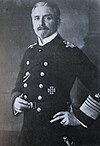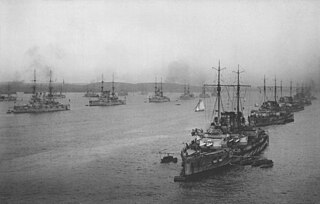
The Imperial German Navy or the Kaiserliche Marine was the navy of the German Empire, which existed between 1871 and 1919. It grew out of the small Prussian Navy, which was mainly for coast defence. Kaiser Wilhelm II greatly expanded the navy. The key leader was Admiral Alfred von Tirpitz, who greatly expanded the size and quality of the navy, while adopting the sea power theories of American strategist Alfred Thayer Mahan. The result was a naval arms race with Britain, as the German navy grew to become one of the greatest maritime forces in the world, second only to the Royal Navy.

Carl Friedrich Heinrich Reinhard Scheer was an Admiral in the Imperial German Navy. Scheer joined the navy in 1879 as an officer cadet and progressed through the ranks, commanding cruisers and battleships, as well as senior staff positions on land. At the outbreak of World War I, Scheer was the commander of the II Battle Squadron of the High Seas Fleet. He then took command of the III Battle Squadron, which consisted of the newest and most powerful battleships in the navy. In January 1916, he was promoted to Admiral and given control of the High Seas Fleet. Scheer led the German fleet at the Battle of Jutland on 31 May – 1 June 1916, one of the largest naval battles in history.

SMS Bayern was the lead ship of the Bayern class of dreadnought battleships in the German Kaiserliche Marine. The vessel was launched in February 1915 and entered service in July 1916, too late to take part in the Battle of Jutland. Her main armament consisted of eight 38 cm (15 in) guns in four turrets, which was a significant improvement over the preceding König's ten 30.5 cm (12 inch) guns. The ship was to have formed the nucleus for a fourth battle squadron in the High Seas Fleet, along with three of her sister ships. Of the other ships only one—Baden—was completed; the other two were canceled later in the war when production requirements shifted to U-boat construction.

Hugo von Pohl was a German admiral who served during the First World War. He joined the Navy in 1872 and served in various capacities, including with the new torpedo boats in the 1880s, and in the Reichsmarineamt in the 1890s. He eventually reached the rank of Vizeadmiral and held the position of Chief of the Admiralty Staff in 1913. As Chief of the Admiralty Staff, Pohl was an outspoken advocate of unrestricted submarine warfare, and he put the policy into effect as he left the post on 1 February 1915.

Eduard von Capelle was a German Imperial Navy officer from Celle. He joined the Imperial German Navy in 1872, serving in various roles, including as an executive officer of the battleship SMS Weissenburg and chief of the administrative department in the Reichsmarineamt. Working closely with Admiral Alfred von Tirpitz, he was primarily responsible for drafting the Flottengesetze, and was promoted to admiral in 1913. He was supportive of Germany's entry into war during July Crisis of 1914.
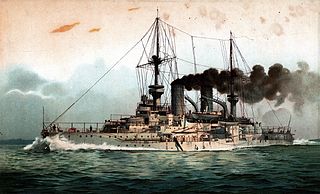
SMS Mecklenburg was the fifth ship of the Wittelsbach class of pre-dreadnought battleships of the German Imperial Navy. Laid down in May 1900 at the AG Vulcan shipyard in Stettin, Germany, she was finished in May 1903. Her sister ships were Wittelsbach, Zähringen, Wettin, and Schwaben; they were the first capital ships built under the Navy Law of 1898, championed by Admiral Alfred von Tirpitz. Mecklenburg was armed with a main battery of four 24-centimeter (9.4 in) guns and had a top speed of 18 knots.
Imperial German plans for the invasion of the United States were ordered by staff officers from 1897 to 1903 as training exercises in planning for war. The hypothetical operation was supposed to force the US to bargain from a weak position and to sever its growing economic and political connections in the Pacific Ocean, the Caribbean, and South America so that German influence could increase there. Junior officers made various plans, but none were seriously considered and the project was dropped in 1906.

SMS Schwaben was the fourth ship of the Wittelsbach class of pre-dreadnought battleships of the German Imperial Navy. Schwaben was built at the Imperial Dockyard in Wilhelmshaven. She was laid down in 1900, and completed in April 1904. Her sister ships were Wittelsbach, Zähringen, Wettin and Mecklenburg; they were the first capital ships built under the Navy Law of 1898, championed by Admiral Alfred von Tirpitz. Schwaben was armed with a main battery of four 24-centimeter (9.4 in) guns and had a top speed of 18 knots.

SMS Hessen was the third of five pre-dreadnought battleships of the Braunschweig class. She was laid down in 1902, was launched in September 1903, and was commissioned into the German Kaiserliche Marine in September 1905. Named after the state of Hesse, the ship was armed with a battery of four 28 cm (11 in) guns and had a top speed of 18 knots. Like all other pre-dreadnoughts built at the turn of the century, Hessen was quickly made obsolete by the launching of the revolutionary HMS Dreadnought in 1906; as a result, she saw only limited service with the German fleet.
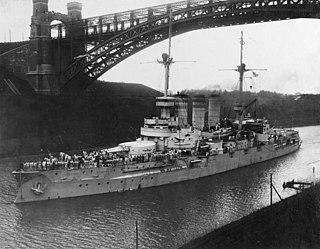
SMS Lothringen was the last of five pre-dreadnought battleships of the Braunschweig class, built for the German Kaiserliche Marine. She was laid down in December 1902, was launched in May 1904, and was commissioned in May 1906. She was named for Lothringen, a province of the German Empire from 1871 to 1918. The ship was armed with a battery of four 28 cm (11 in) guns and had a top speed of 18 knots. Like all other pre-dreadnoughts built around the turn of the century, Lothringen was quickly made obsolete by the launching of the revolutionary HMS Dreadnought in December 1906; as a result, her career as a front-line battleship was cut short.
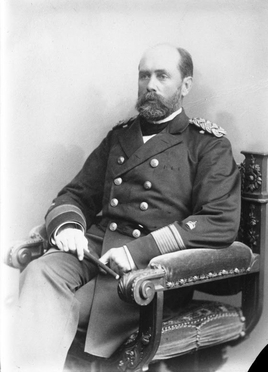
Ernst Otto von Diederichs was a German admiral of the Prussian Navy who served both the Kingdom of Prussia and the German Empire. He was the first governor of the German Jiaozhou Bay concession in China.

The Imperial Naval Office was a government agency of the German Empire. It was established in April 1889, when the German Imperial Admiralty was abolished and its duties divided among three new entities: the Imperial Naval High Command, the Imperial Naval Cabinet and the Imperial Naval Office performing the functions of a ministry for the Imperial German Navy.
Friedrich von Hollmann was an Admiral of the German Imperial Navy and Secretary of the German Imperial Naval Office under Emperor Wilhelm II.

The German Imperial Naval High Command was an office of the German Empire which existed from 1 April 1889 until 14 March 1899 to command the German Imperial Navy. A similarly named office existed in the Prussian Navy and the Kriegsmarine of Nazi Germany.

SMS Gefion was an unprotected cruiser of the German Kaiserliche Marine, the last ship of the type built in Germany. She was laid down in March 1892, launched in March 1893, and completed in June 1895 after lengthy trials and repairs. The cruiser was named after the earlier sail frigate Gefion, which had been named for the goddess Gefjon of Norse mythology. Intended for service in the German colonial empire and as a fleet scout, Gefion was armed with a main battery of ten 10.5-centimeter (4.1 in) guns, had a top speed in excess of 19.5 knots, and could steam for 3,500 nautical miles, the longest range of any German warship at the time. Nevertheless, the conflicting requirements necessary for a fleet scout and an overseas cruiser produced an unsuccessful design, and Gefion was rapidly replaced in both roles by the newer Gazelle class of light cruisers.

SMS Oldenburg was the fourth vessel of the Helgoland class of dreadnought battleships of the Imperial German Navy. Oldenburg's keel was laid in March 1909 at the Schichau-Werke dockyard in Danzig. She was launched on 30 June 1910 and was commissioned into the fleet on 1 May 1912. The ship was equipped with twelve 30.5 cm (12 in) guns in six twin turrets, and had a top speed of 21.2 knots. Oldenburg was assigned to I Battle Squadron of the High Seas Fleet for the majority of her career, including World War I.

The High Seas Fleet was the battle fleet of the German Imperial Navy and saw action during the First World War. The formation was created in February 1907, when the Home Fleet was renamed as the High Seas Fleet. Admiral Alfred von Tirpitz was the architect of the fleet; he envisioned a force powerful enough to challenge the Royal Navy's predominance. Kaiser Wilhelm II, the German Emperor, championed the fleet as the instrument by which he would seize overseas possessions and make Germany a global power. By concentrating a powerful battle fleet in the North Sea while the Royal Navy was required to disperse its forces around the British Empire, Tirpitz believed Germany could achieve a balance of force that could seriously damage British naval hegemony. This was the heart of Tirpitz's "Risk Theory", which held that Britain would not challenge Germany if the latter's fleet posed such a significant threat to its own.

The II Battle Squadron was a unit of the German High Seas Fleet before and during World War I. The squadron saw action throughout the war, including the Battle of Jutland on 31 May – 1 June 1916, where it formed the rear of the German line.

SMS Württemberg was the fourth and final member of the Bayern-class dreadnought battleships ordered but never finished for the German Kaiserliche Marine in the 1910s, sometimes considered to be part of a sub-class with her sister Sachsen. She was to be armed with the same main battery of eight 38 cm (15 in) guns in four gun turrets. Originally intended to serve as a fleet flagship, the start of World War I in July 1914 forced the Navy to simplify her design in the hopes that she could be completed in time to see service during the conflict. She was laid down in January 1915 at the AG Vulcan shipyard, but as resources were diverted to more pressing projects, including U-boat construction, work on the ship slowed; she was launched in June 1917, but only to clear the slipway for other work. By the time construction stopped, she was about twelve months from completion. The Treaty of Versailles that ended the war in June 1919 specified that all warships under construction in Germany were to be destroyed, and Württemberg was accordingly sold for scrap in 1921 and dismantled the following year.







